

Related Concepts. Agile Team Size and the Ringelmann Effect. Teams influence individual performance in many ways.

In a previous post, we talked about the Köhler effect - the impact of having team members with lesser skills working with stronger teammates to improve performance. In this case, being a part of a team is providing a positive influence. Another potential dynamic may be affecting your team performance but with negative influence – when the overall size of the team grows too large the Ringelmann effect may set in.
The Ringelmann effect occurs when individual performance begins to diminish as the size of the team increases. This phenomena can also be known as “social loafing.” While one would think this would occur because of the additional coordination necessary for a larger group, it is believed to originate because one or more members of the team are lacking in motivation. Teams, and especially Agile teams, cannot tolerate this type of behavior for very long so keeping our teams small and self-accountable is important. Latane et. al: Social Loafing. Latane, B., Williams, K., & Harkins, S., Many Hands Make Light The Work: The Causes and Consequences of Social Loafing, JPSP, 37, 822-832.
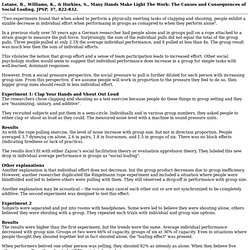
"Two experiments found that when asked to perform a physically exerting tasks of clapping and shouting, people exhibit a sizable decrease in individual effort when performaing in groups as comapred to when they perform alone". In a previous study over 50 years ago a German researcher had people alone and in groups pull on a rope attached to a strain guage to measure the pull force. Surprisingly, the sum of the individual pulls did not equal the total of the group pulls. Three people pulled at only 2.5X the average individual performance, and 8 pulled at less than 4x. The group result was much less then the sum of individual efforts. This vilolates the notion that group effort and a sense of team participation leads to increased effort.
They recruited subjects and put them in a semi-circle. 2. 3. Clay Shirky: Institutions vs. collaboration. CSCW. The term computer-supported cooperative work (CSCW) was first coined by Irene Greif and Paul M.
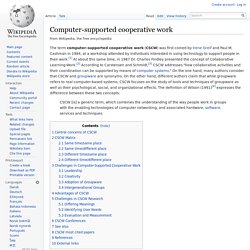
Cashman in 1984, at a workshop attended by individuals interested in using technology to support people in their work.[1] At about this same time, in 1987 Dr. Charles Findley presented the concept of Collaborative Learning-Work.[2] According to Carstensen and Schmidt,[3] CSCW addresses "how collaborative activities and their coordination can be supported by means of computer systems. " On the one hand, many authors consider that CSCW and groupware are synonyms. On the other hand, different authors claim that while groupware refers to real computer-based systems, CSCW focuses on the study of tools and techniques of groupware as well as their psychological, social, and organizational effects.
The definition of Wilson (1991)[4] expresses the difference between these two concepts: Central concerns of CSCW[edit] CSCW Matrix[edit] Same time/same place[edit] Face to face interaction. Robert E. Kraut. Robert E.

Kraut (born 30 August 1946) is an American social psychologist who studies human-computer interaction, online communities, internet use, group coordination, computers in organizations, and the role of visual elements in interpersonal communication. He is a Herbert Simon Professor of Human-computer Interaction at the Human-Computer Interaction Institute at Carnegie Mellon University. Background[edit] Robert Kraut graduated Phi Beta Kappa from Lehigh University in 1968 and received his Ph.D. in social psychology from Yale University in 1973.[1] He joined the sociology faculty at the University of Pennsylvania in 1972 and moved to Cornell University in 1974. In 1980, Kraut joined Bell Labs as a visiting scientist and departed Cornell in 1981 to become a full-time scientist working in Bell's Interface Planning group. He was elected to the CHI Academy in 2003. Applying Social Psychology To Group Work.
Kraut's Homepage. Robert E.

Kraut Herbert A. Simon Professor of Human-Computer Interaction Human-Computer Interaction Institute, School of Computer Science Tepper School of Business Center for the Future of Work, Heinz College Carnegie Mellon University Ph.D., Social Psychology, Yale University, 1973 Dr. Kraut has broad interests in the design and social impact of computing and has conducted empirical research on online communities, the social impact of the internet, the design of information technology for small-group intellectual work, the communication needs of collaborating scientists, the impact of computer networks on organizations, office automation and employment quality, and technology and home-based employment.
His research in specific areas examines in detail the challenges groups currently have in performing social tasks, designs new technology to meet some of these challenges, and evaluates the usefulness of the new technology. Robert Krauts Wikipedia User Account. I am a social psychologist, who conducts research on how Wikipedia operates and what makes parts of it successful.
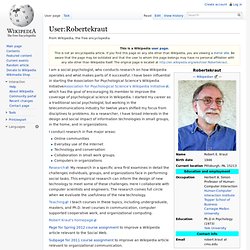
I have been influential in starting the Association for Psychological Science's Wikipedia InitiativeAssociation for Psychological Science's Wikipedia Initiative, which has the goal of encouraging its member to improve the coverage of psychological science in Wikipedia. I started my career as a traditional social psychologist, but working in the telecommunications industry for twelve years shifted my focus from disciplines to problems. As a researcher, I have broad interests in the design and social impact of information technologies in small groups, in the home, and in organizations. I conduct research in five major areas: Online communitiesEveryday use of the InternetTechnology and conversationCollaboration in small work groups.Computers in organizations. Jonathan Grudin.
Jonathan Grudin is a Principal Researcher at Microsoft Research in the fields of human-computer interaction (HCI) and computer-supported cooperative work (CSCW).

Grudin is a pioneer of the field of CSCW and one of its most prolific contributors.[1] His collaboration distance to other HCI researchers has been described by the Grudin number, similar to the Erdős number in mathematics.[1] Grudin is also well known for the Grudin Paradox or Grudin Problem, which states basically with respect to the design of collaborative software for organizational settings, "What may be in the managers' best interests may not be in the ordinary users' interests. Jonathan Grudin Microsoft Researcher. Jonathan Grudin Principal Researcher, Natural Interaction Group, Microsoft Research Affiliate Professor, Information School, University of Washington Research: Human Computer Interaction, Computer Supported Cooperative Work Previously: Professor of Information and Computer Science, UC Irvine Visiting Professor: Aarhus University, Keio University, University of Oslo Employers: MRC Applied Psychology Unit, Wang Laboratories, MCC Ph.D.: Cognitive psychology, UC San Diego with Donald Norman(CV as of 1998, when I joined Microsoft)
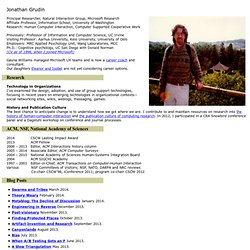
JonathanGrudin. Sherry Turkle. Connecting (Full Film) Alone in the crowd. People today are more connected to one another than ever before in human history, thanks to Internet-based social networking sites and text messaging.

But they’re also more lonely and distant from one another in their unplugged lives, says Massachusetts Institute of Technology social psychologist Sherry Turkle, PhD. This is not only changing the way we interact online, it’s straining our personal relationships, as well. Turkle’s new book, “Alone Together” (Basic Books, 2011), explores the ways online social networks and texting culture are changing how people relate to society, their parents and friends. The book is based on meta-analyses of individual and family studies and her own interviews with 300 children and 150 adults. Sherry Turkle. Sherry Turkle: Connected, but alone? About Social Psychology. Approach from Social Psychology. Social psychology theories let us evaluate our group dynamic.
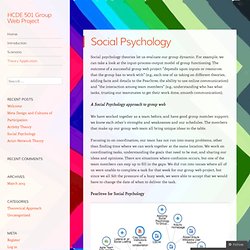
For example, we can take a look at the input-process-output model of group functioning. The outcome of a successful group web project “depends upon inputs or resources that the group has to work with” (e.g., each one of us taking on different theories, adding facts and details to the Pearltree, the ability to use online communication) and “the interaction among team members” (e.g., understanding who has what tasks, trusting our teammates to get their work done, smooth communication).